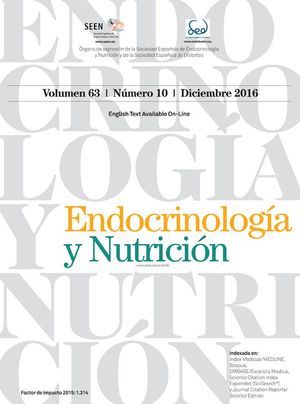Hypercalcemia of malignancy is a well-known disorder, often due to elevated parathyroid hormone-related peptide levels (PTHrP). PTHrP-mediated hypercalcemia has been rarely described in association with bladder carcinoma. Here we describe two such cases, each with a unique feature: the first case with concomitant primary hyperparathyroidism and the second case refractory to bisphosphonate therapy.
In the first case, a 77-year-old female, with a history of primary hyperparathyroidism and recently diagnosed invasive, high-grade poorly differentiated metastatic bladder carcinoma with squamous features who underwent total cystectomy, presented with weakness, abdominal pain, and constipation. CT imaging of the abdomen revealed multiple rim-enhancing fluid collections in the lower abdomen and pelvis. Aspirate of the fluid collections revealed metastatic carcinoma with squamous differentiation, consistent with urothelium origin.
The patient had limited knowledge of her past medical history. She was able to state that she has primary hyperparathyroidism but she did not know when or how the diagnosis was made. However, she could say that she had had taken cinacalcet in the past but stopped because she could not afford the medication.
Laboratory evaluation was notable for calcium 3.09mmol/L (2.15–2.57), albumin 30g/L (39–50), ionized calcium 1.84mmol/L (1.09–1.29), creatinine 106.1μmol/L (53.0–115.0), phosphorus 0.68mmol/L (0.74–1.42), intact parathyroid hormone 131ng/L (11–51), vitamin D, 25 hydroxy 22.5pmol/L (49.9–124.8) and vitamin D, 1,25 hydroxy 93.1pmol/L (49.7–197.9). The PTHrP level was 87ng/L (14–27).
She was started on intravenous hydration, cinacalcet 30mg daily, and cholecalciferol 800IU daily. Two days later, calcium levels decreased to a nadir of 2.45mmol/L and ionized calcium of 1.47mmol/L. However, the patient's abdominal pain and constipation worsened. Repeat CT imaging showed bowel obstruction. With this, oral intake of food and medications, including cinacalcet, was stopped. Calcium then trended upwards to a calcium 2.92mmol/L and ionized calcium of 1.74mmol/L. Intravenous zoledronic acid 4mg was administered with subsequent resolution of hypercalcemia.
The bowel obstruction persisted and the patient developed hydronephrosis, which led to kidney failure. Given the patient's overall poor prognosis and her goals of care, the patient was transitioned to comfort care and passed.
In the second case, a 65-year-old male with a high-grade bladder carcinoma metastatic to lymph nodes, who was admitted for transurethral resection of bladder tumor and percutaneous nephrostomy tube placement for bilateral hydronephrosis, was found to be hypercalcemic. The patient noted recent worsening of fatigue and constipation.
Laboratory evaluation was notable for calcium 3.24mmol/L (2.15–2.57), ionized calcium 1.78mmol/L (1.09–1.29), creatinine 176.8μmol/L (53.0–115.0), phosphorus 1.42mmol/L (0.74–1.42), albumin 27g/L (39–50), and intact parathyroid hormone 6ng/L (11–51). The PTHrP level was 49ng/L (14–27).
The patient received intravenous zoledronic acid 4mg with improvement in serum calcium. He subsequently received two more monthly doses of intravenous zoledronic acid 4mg. He was treated with a chemotherapy regimen of methotrexate, vinblastine, doxorubicin, and cisplatin.
Six months later, he was admitted after a mechanical fall resulting in a minimally displaced fracture of the right greater trochanter. He was again noted to be hypercalcemic with calcium 2.94mmol/L, ionized calcium 1.6mmol/L, creatinine 884μmol/L, and PTHrP 56ng/L. Two doses of intravenous pamidronate 60mg were administered with minimal improvement in calcium. Given the lack of response to the bisphosphonate, subcutaneous denosumab 120mg was administered with subsequent normalization of calcium levels.
The hospital course was complicated by urosepsis and progressive deconditioning. In addition, further imaging showed progression of metastatic disease with increased lymph node involvement and multiple new liver lesions, suspicious for metastatic disease. Given these two factors, he was deemed not to be an appropriate candidate for further systemic therapy. His mental status gradually worsened and he was transitioned to comfort care and passed. Autopsy revealed metastatic carcinoma with complete involvement of the bladder mucosa as well as involvement of pleura, lung, pericardium, multiple lymph nodes, diaphragm, liver, spleen, bilateral adrenal glands, bowel serosa, omentum, prostate, pericystic tissue, abdominal wall, and peritesticular tissue.
Hypercalcemia of malignancy is a well-known disorder. It is most commonly caused by elevated parathyroid hormone related peptide levels (PTHrP), but there can be other etiologies such as due to elevated 1,25-dihydroxy-vitamin D production, osteolytic hypercalcemia, or rarely due to concurrent elevated PTHrP and 1,25-dihydroxy-vitamin D production.1,2 PTHrP-mediate hypercalcemia has been associated with a variety of cancers, both solid organ and hematologic malignancies. In a retrospective study of malignancies affected by PTHrP-mediated hypercalcemia, 85.2% of cases were in solid organ malignancies, of which squamous cell carcinoma of the lung were most common. Only 1.7% of cases were in bladder carcinomas.3 PTHrP-mediated hypercalcemia associated with bladder carcinoma is indeed rare and has been reported in case reports.4 The two cases described here have the unique features of (1) a case of primary hyperparathyroidism and PTHrP-mediated hypercalcemia in bladder carcinoma and (2) a case of PTHrP-mediated hypercalcemia refractory to bisphosphonates.
Coexistent primary hyperparathyroidism and PTHrP-mediated hypercalcemia is uncommon. Although this combination has been reported in a variety of malignancies, to our knowledge, we have come across only one other such case report of coexistent primary hyperparathyroidism and PTHrP-mediated hypercalcemia in a patient with transitional cell carcinoma of the bladder.5
Definitive management of hypercalcemia of malignancy requires treatment of the malignancy. In the interim, management of hypercalcemia first begins with aggressive hydration to promote urinary calcium excretion and then if necessary, bisphosphonate therapy to inhibit bone resorption. Less commonly, hypercalcemia does not improve with these interventions. Recently, denosumab, a monoclonal antibody that binds to RANKL to ultimately limit bone resorption, has been studied as a therapy for hypercalcemia of malignancy refractory to bisphosphonates.6,7 In the second patient case, the hypercalcemia was initially responsive to bisphosphonate therapy but subsequently became refractory. This may have been a result of a higher burden of disease, as noted on autopsy with significant metastases in numerous sites.
In conclusion, hypercalcemia of malignancy due to elevated PTHrP is a well-known condition; however, it is not commonly associated with bladder carcinoma. Here we describe two such cases, with two additional features of coexistent primary hyperparathyroidism and refractoriness to bisphosphonate therapy.
Conflicts of interestThe authors declare no conflicts of interest.






